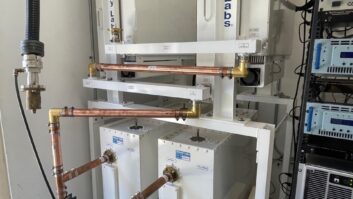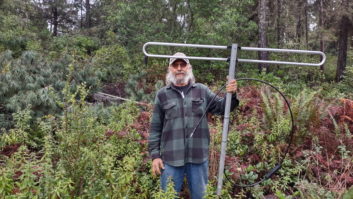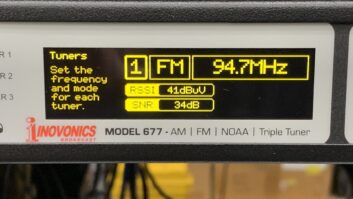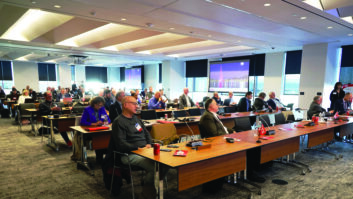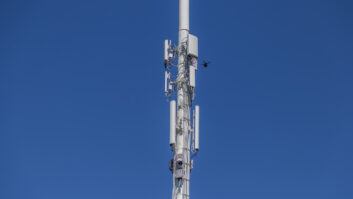Testing AM Antennas
Mar 1, 2014 7:32 AM, By Jeremy Ruck, PE
There are different ways, techniques, and equipment available to test antennas. As with any antenna system, regular testing as a component of an overall maintenance program will ensure maximum performance, and limit failure related downtime.
Generally speaking, we can cluster testing methodologies under two main headings: basic and advanced. Basic procedures can and should be performed by the station engineer. These procedures are supplemented by more involved methods usually performed by consultants or at the corporate level. This second group tends to be undertaken beyond the local level because of the substantial monetary investment required in equipment, often not possible at the local level.

At the heart of basic testing procedures are acquisition of phase monitor readings, common point and/or base current values, and monitor point or reference location field strength readings. Obviously, the availability and necessity of certain portions of this data will depend on the configuration of your antenna. Although no longer required by the Commission, maintenance of base current measurement equipment in directional antennas is highly recommended, as this data provides another cross-check of other parameters.
Frequent acquisition of this data will provide a good historical record, and will aid in determining if an anomaly is seasonal, or an indication of a more sinister issue. As a consultant, it can be somewhat frustrating assisting a facility where there is no such record. Even worse is the station where the locations of the monitor points are completely unknown. Don’t be that guy.
Bad readings
Anomalous readings in one sector of the data are not necessarily an indication of a substantial problem with the system. For instance, if the phase monitor readings are well out of tolerance, but the transmitter is still happy, base current ratios are within norms, and monitor points do not exceed limits, it is a good bet that the problem lies in the sampling system itself. Similarly, if a couple monitor points have drifted outside their limits, then we need to look at the environmental conditions to see if a point has gone haywire, or if there truly has been an increase in the radiated field along that azimuth. A series of field strength measurements on those azimuths compared to the last full proof will usually provide that answer.
Probably one of the most glaring exceptions to this may deal with common point current (for a directional) or base current (for a non-directional). Sudden changes in these values, coupled with an unhappy transmitter, almost certainly indicate an acute issue with the system, requiring additional testing, maybe even down to the component level. A more gradual change over time is likely more indicative of system aging, such as ground system deterioration. Either way, swapping the meter or inserting a similar meter in series will tend to confirm or exclude measurement error.
– continued on page 2
Testing AM Antennas
Mar 1, 2014 7:32 AM, By Jeremy Ruck, PE
If the phase monitor readings have changed drastically, but everything else looks correct, a simple test can be performed to ensure the inputs are all still reading properly. A coax tee adapter can be installed on one of the phase monitor inputs. The sample from one tower can then be split between that input and another input. Working across all the inputs, the ratio and phase should be very similar on both channels being fed. If they are not, then it tends to point to a problem with the monitor.
Bigger problems
At the more detailed levels of testing, we drill down deeper into the array to look at what is transpiring there. To do this, a couple of more pricey pieces of test equipment make this job easier. First and foremost is the impedance bridge, with the network analyzer being the icing on the cake. Although some engineers have more or less relegated the impedance bridge to the shelf in favor of the network analyzer, I still consider the bridge the first line of attack.
The most versatile of the bridges is the operating impedance bridge. These designs allow measurement of impedances when the system is being driven by the transmitter. Currently available models typically allow for a 5kW maximum input power when modulating or 10kW with carrier only. The operating bridge also permits cold operation where the bridge is driven by a low-power driver, and the return signal picked up by a receiver. The most convenient way to do this is with package units such as the Potomac Instruments SD-31 or Delta Electronics RG-4B, although many other generators and receivers will work well.
The importance of being able to measure impedance in both cold and hot states cannot be understated. In directional antennas, the self impedance of the tower will be transformed to a different impedance when the array is active due to the mutual coupling between the elements. Additionally, other issues may only rear their ugly heads when there is a fair amount of power being shoved down the pipe.
The network analyzer is very valuable due to its ability to rapidly illustrate system conditions graphically. Base network analyzer models will be scalar versions, which look only at the magnitude component. Such models have limited usefulness since the all-important phase measurements are ignored. The big brother to the scalar models is the vector network analyzer, which will add the phase component. The big daddy of all, however, is the VNA with time domain capabilities. This allows testing of the transmission line portions of the antenna systems.
Due to technological increases, the size of the network analyzer has shrunk from a pile of boat anchors requiring a pickup truck, to models that now fit quite comfortably under an airline seat weighing less than 15 pounds. At the same time, the performance and options have increased, and the data presentation is much nicer. New high-performance models will still run from around $30,000 to eye watering prices in six figures, which tend to be out of reach economically for most stations.
However, one available model that has gained significant traction in the broadcast arena is PC-driven, about the size of two packs of smokes, and costs just under $3,000. What makes this particular model attractive, beyond the price and size, is the fact that it provides a wide range of data, including a distance-to-fault method. Due to the limitations of the design, the DTF will not provide data as robust as a powerful VNA, but will give a good first order approximation to potential issues with transmission lines in an AM system.
As we all know, an AM antenna is a living and breathing animal, and each has a unique personality. Some are nice and stable like grandma, while others can be as problematic as the most petulant teenager. There is no magic to testing them, but such efforts can be time consuming because of their size and complexity. In reality much of the run-of-the-mill testing required can be accomplished by the station engineer. The key is to know your antenna, stay on top of regular testing, and perform robust maintenance. All of these are tasks that are becoming more problematic due to economic and personnel considerations, but that is a discussion for another day.
Ruck is the principal engineer of Jeremy Ruck and Associates, Canton, IL.
March 2014
New products at the 2014 NAB Show, handling metadata in automation, testing AM antennas, IP codecs and more….





